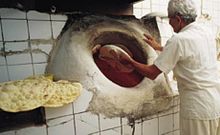 Preparation of khubz tannur 'tandoor bread' Preparation of khubz tannur 'tandoor bread' | |
| This article may lack focus or may be about more than one topic. Please help improve this article, possibly by splitting the article and/or by introducing a disambiguation page, or discuss this issue on the talk page. (November 2024) |
Khubz, alternatively transliterated as khoubz, khobez, khubez, or khubooz, is the usual word for "bread" in Standard Arabic and in many of the vernaculars.
Among the breads popular in Middle Eastern countries are "pocket" pita bread in the Levant and Egypt, and the flat tannur bread in Iraq.
The oldest known kind of bread, found by archaeologists in the Syrian Desert (modern-day southern Syria and northern Jordan), dates back 14,000 years. It was a sort of unleavened flatbread made with several types of wild cereals.
Tannur bread
In Iraq, the most popular bread is the Tannur bread (ḵubz al-tannūr, خبز التنور) which resembles other slightly leavened flatbreads such as Iranian nan-e barbari, Central and South Asian flatbreads (such as naan), and pizza base. (See also tandoor bread and taboon bread.)
The word tannur comes from the Akkadian word tinūru (𒋾𒂟), which consists of the parts tin 'mud' and nuro/nura 'fire' and is mentioned as early as in the Akkadian Epic of Gilgamesh.
Six recipes for bread baked in a tannur are included in Ibn Sayyar al-Warraq's 10th century Kitab al-Tabikh cookery book.
As a result of the economic sanctions imposed on Iraq in the 1990s there was an increase in the making of bread in the traditional way in a tannur.
Pita bread
Main article: PitaPita is a flatbread found in many Mediterranean, Balkan, and Middle Eastern cuisines. In Arab countries, pita bread is produced as a round flatbread, 18 cm (7 in) to 30 cm (12 in) in diameter. It is thin and puffs up as it bakes. Since it does not contain any added fat, it dries out rapidly and is best consumed while still warm; later, it may become chewy.
The "pocket" pita originated in the Middle East. It is also known as Arab(ic) bread, Lebanese bread, or Syrian bread.
In Egyptian, Palestinian, Jordanian, Lebanese, and Syrian cuisine, almost every savory dish can be eaten in or on pita bread. It is one of the staple food items in the Lebanese cuisine. Common fillings include falafel, lamb or chicken shawarma, kebab, omelettes such as shakshouka (eggs and tomatoes), hummus, and other mezes.
Nationals of other countries, for example, South Asians, also consume it as a replacement for roti with curries, cooked vegetables or meat (dry or gravy).
See also
References
- "Archaeologists find world's oldest bread and new evidence of sophisticated cooking dating back 14,000 years". The Independent. Retrieved 2018-07-17.
- Monier-Williams, Monier (1872). A Sanskrit-English dictionary, etymologically and philologically arranged, with special reference to Greek, Latin, Gothic, German, Anglo-Saxon, and other cognate Indo-European languages. Robarts - University of Toronto. Oxford Clarendon Press.
- Doug Smith (1 December 2007). "Iraqi bakeries make dough while they can". Los Angeles Times. Retrieved 15 March 2011.
- "Khubz. Arabic Bread". Al Mashriq (The Levant). Archived from the original on 3 October 2016. Retrieved 2 October 2016. from Khayat, Marie Karam; Keatinge, Margaret Clark (1959). Food from the Arab World. Beirut: Khayat's.
- ^ Stewart, Jean E.; Tamaki, Junko Alice (1992). Composition of foods: baked products : raw, processed, prepared. Vol. 8. United States Department of Agriculture, Nutrition Monitoring Division. p. 6. ISBN 9780160380440.
Pita bread originated in the Middle East and is also known as Arabic, Syrian, and pocket bread.
- Elasmar, Michael G. (2014). The Impact of International Television: A Paradigm Shift. Routledge. p. 188. ISBN 9781135635060.
- Wright, Clifford A. (2003). Little Foods of the Mediterranean: 500 Fabulous Recipes for Antipasti, Tapas, Hors D'Oeuvre, Meze, and More. Harvard Common Press. p. 61. ISBN 9781558322271.
- Serna-Saldivar, Sergio O. (2012). Cereal Grains: Laboratory Reference and Procedures Manual. CRC Press. p. 215. ISBN 9781439855652.
| Lebanese cuisine | |
|---|---|
| Beverages | |
| Breads | |
| Meze | |
| Cheeses | |
| Soups | |
| Dishes | |
| Grilled meats | |
| Desserts | |
| Frequent ingredients | |
| Unique instruments | |
| Related cuisines | |
| Jewish cuisine | |||||||||||
|---|---|---|---|---|---|---|---|---|---|---|---|
| History | |||||||||||
| Types | |||||||||||
| Religious dietary laws and related terms | |||||||||||
| Chefs | |||||||||||
| Religious foods | |||||||||||
| Breads |
| ||||||||||
| Sweets |
| ||||||||||
| Pastries | |||||||||||
| Fried foods |
| ||||||||||
| Dumplings, pastas and grain dishes |
| ||||||||||
| Casseroles and savory baked dishes | |||||||||||
| Snacks and other baked goods | |||||||||||
| Sandwiches | |||||||||||
| Egg dishes | |||||||||||
| Meat dishes | |||||||||||
| Fish dishes | |||||||||||
| Salads and pickles | |||||||||||
| Vegetable dishes | |||||||||||
| Soups and stews | |||||||||||
| Cheeses and other dairy products | |||||||||||
| Condiments, dips and sauces | |||||||||||
| Beverages | |||||||||||
| Herbs, spices and seasonings | |||||||||||
| Eateries | |||||||||||
| Related lists | |||||||||||
